Chickpea Bowls with Peanut Sauce
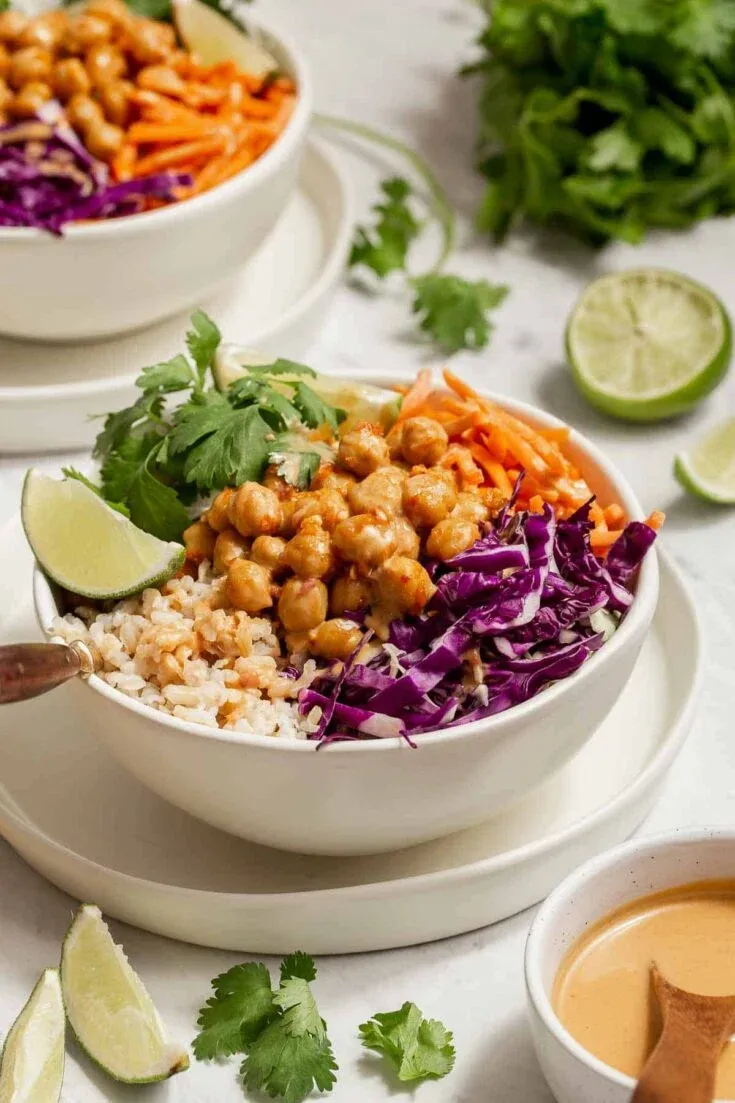
These chickpea bowls are basically a one-way ticket to feeling like you’ve got your culinary life together, even if your kitchen looks like a tornado hit it.
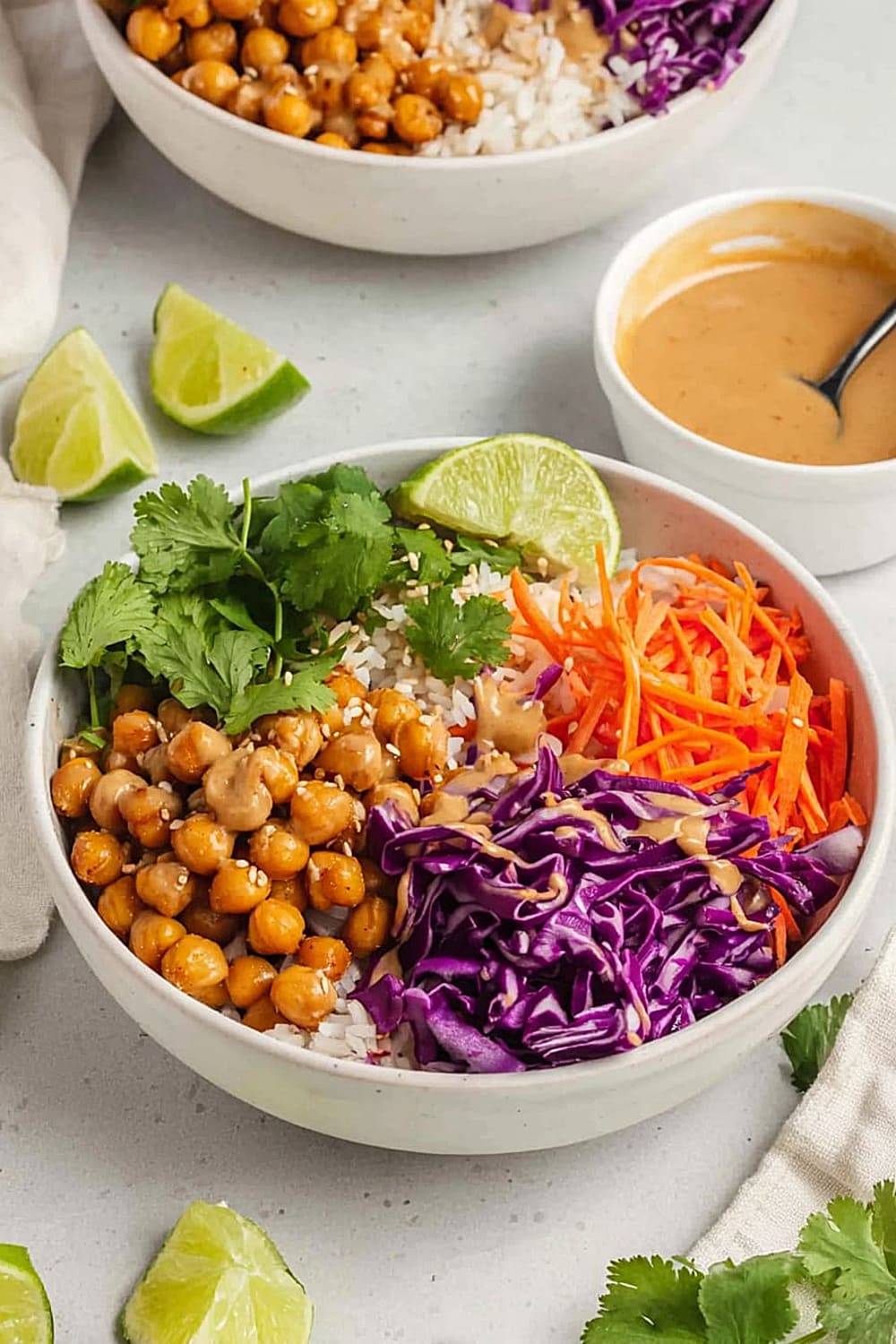
The sticky, caramelized chickpeas get this incredible golden-brown coating that’s sweet, spicy, and absolutely addictive – you’ll be sneaking bites straight from the pan.

That creamy peanut sauce drizzled on top transforms everything into pure comfort food magic, with just enough heat to wake up your taste buds without setting your mouth on fire.
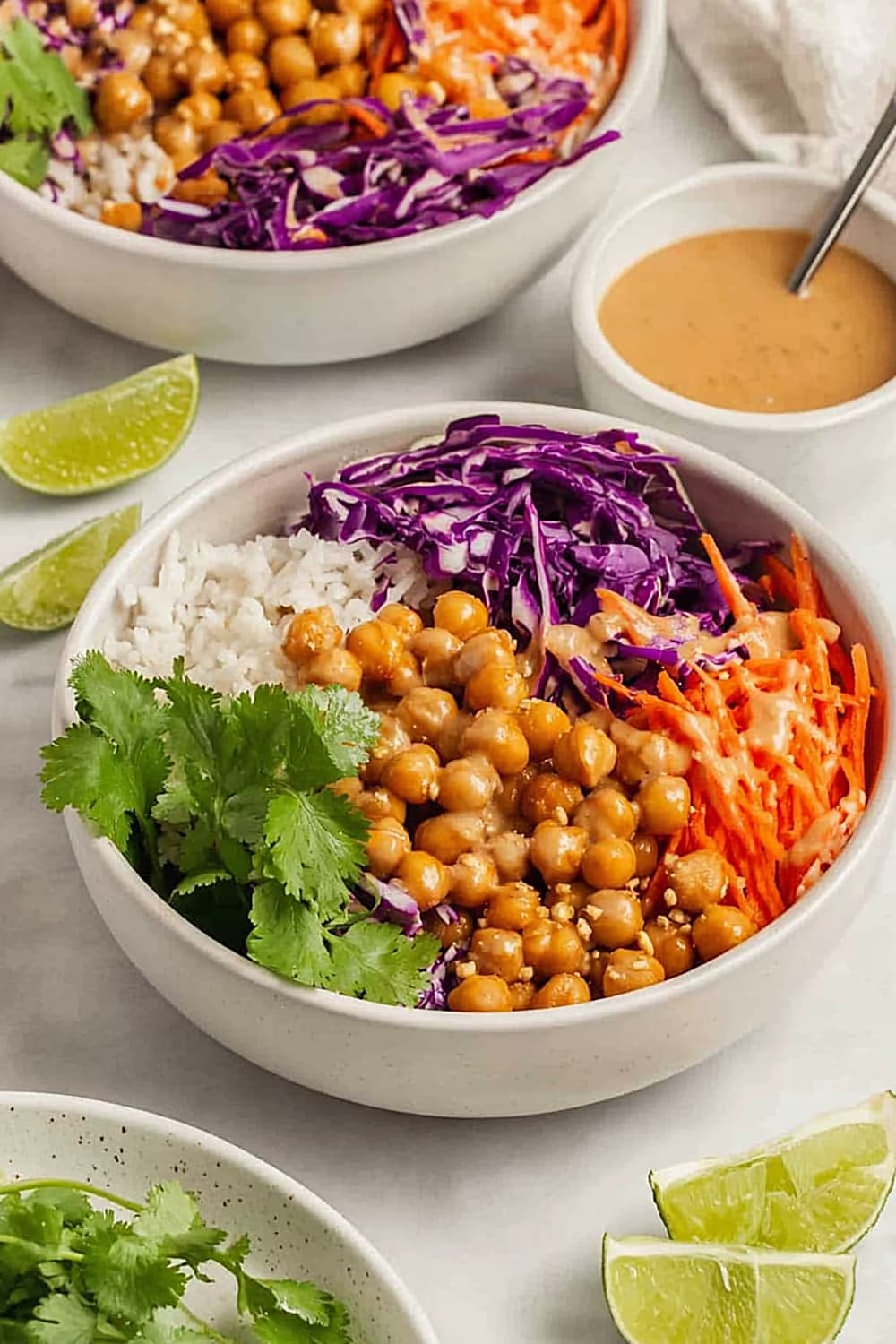
The best part is watching people’s faces when they realize this restaurant-quality bowl came from your actual kitchen, not some trendy spot downtown.
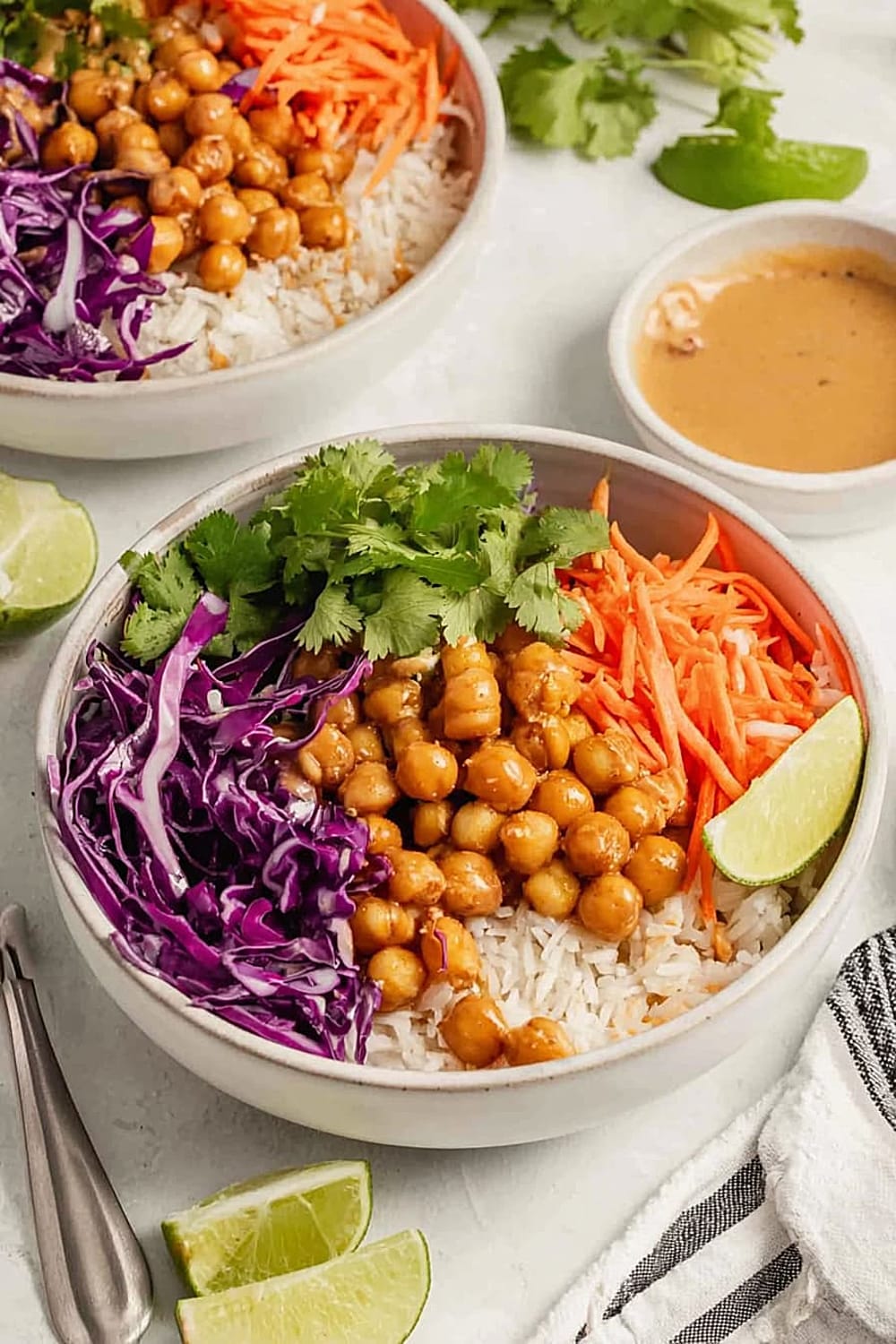
Fresh, crunchy vegetables add the perfect contrast to those tender, sauce-glazed chickpeas, creating textures that’ll make every bite interesting.

This is the kind of meal that makes you feel like a cooking show host, complete with the satisfaction of knowing you just created something genuinely impressive without breaking a sweat.
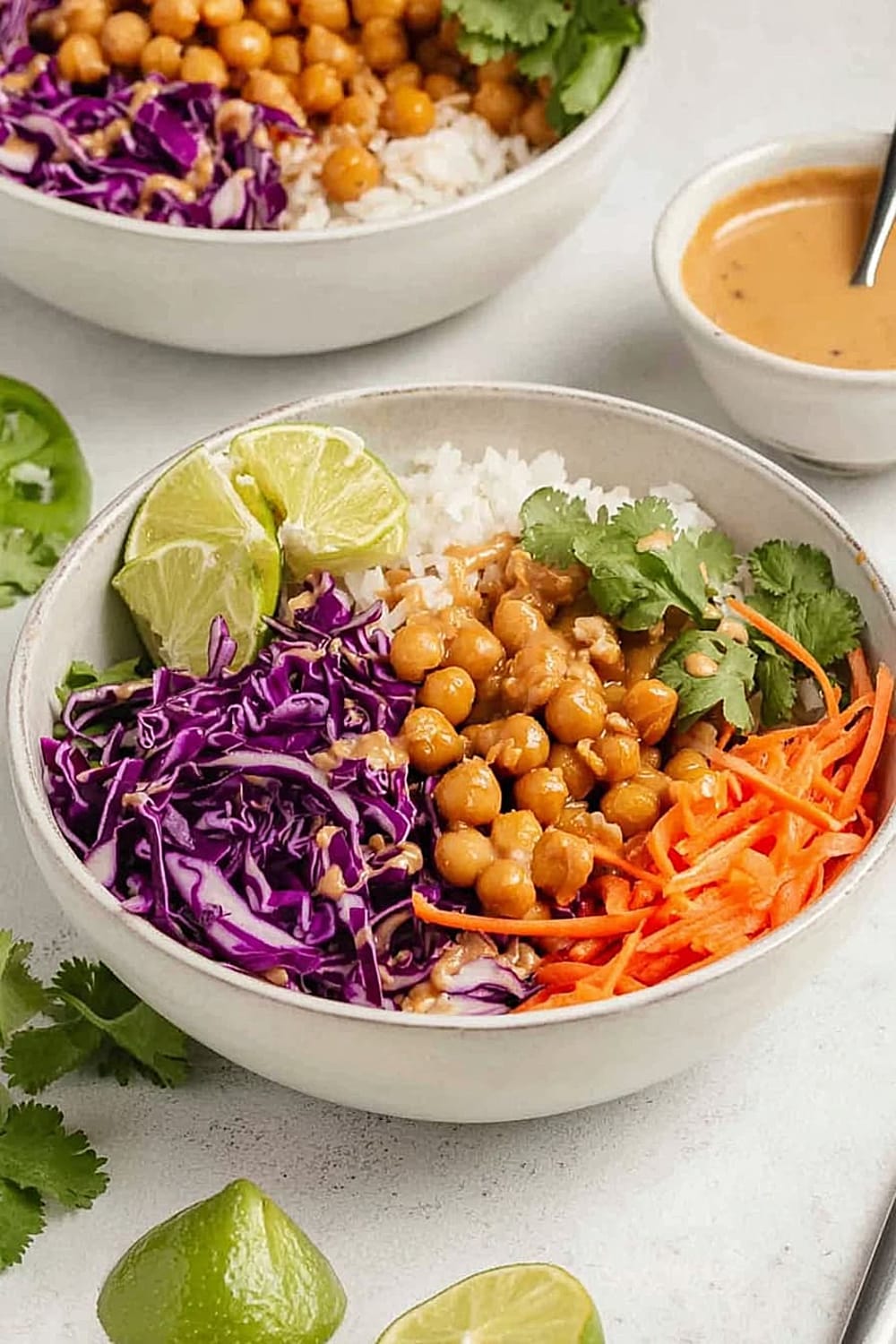
Ingredients
Yield: 4 servings
Prep Time: 20 minutes
Cook Time: 35 minutes
Total Time: 55 minutes
For the Rice:
- 1 cup white or brown long-grained rice
- 2 cups water
For the Chickpeas:
- 1 tablespoon olive oil
- 1 clove garlic, minced
- 1 tablespoon freshly grated ginger
- 1 tablespoon sambal oelek
- 1 tablespoon brown sugar
- 1 tablespoon fresh lime juice
- 1 tablespoon soy sauce
- 1 tablespoon cornstarch
- 1 (15-ounce) can chickpeas
For the Spicy Peanut Sauce:
- 3 tablespoons natural peanut butter
- 2 tablespoons fresh lime juice
- 1 tablespoon soy sauce
- 1 tablespoon brown sugar
- 2 teaspoons sambal oelek
- 3 tablespoons warm water
For the Bowls:
- 2 cups shredded cabbage
- 1 cup shredded carrots
- ½ cup fresh cilantro, chopped
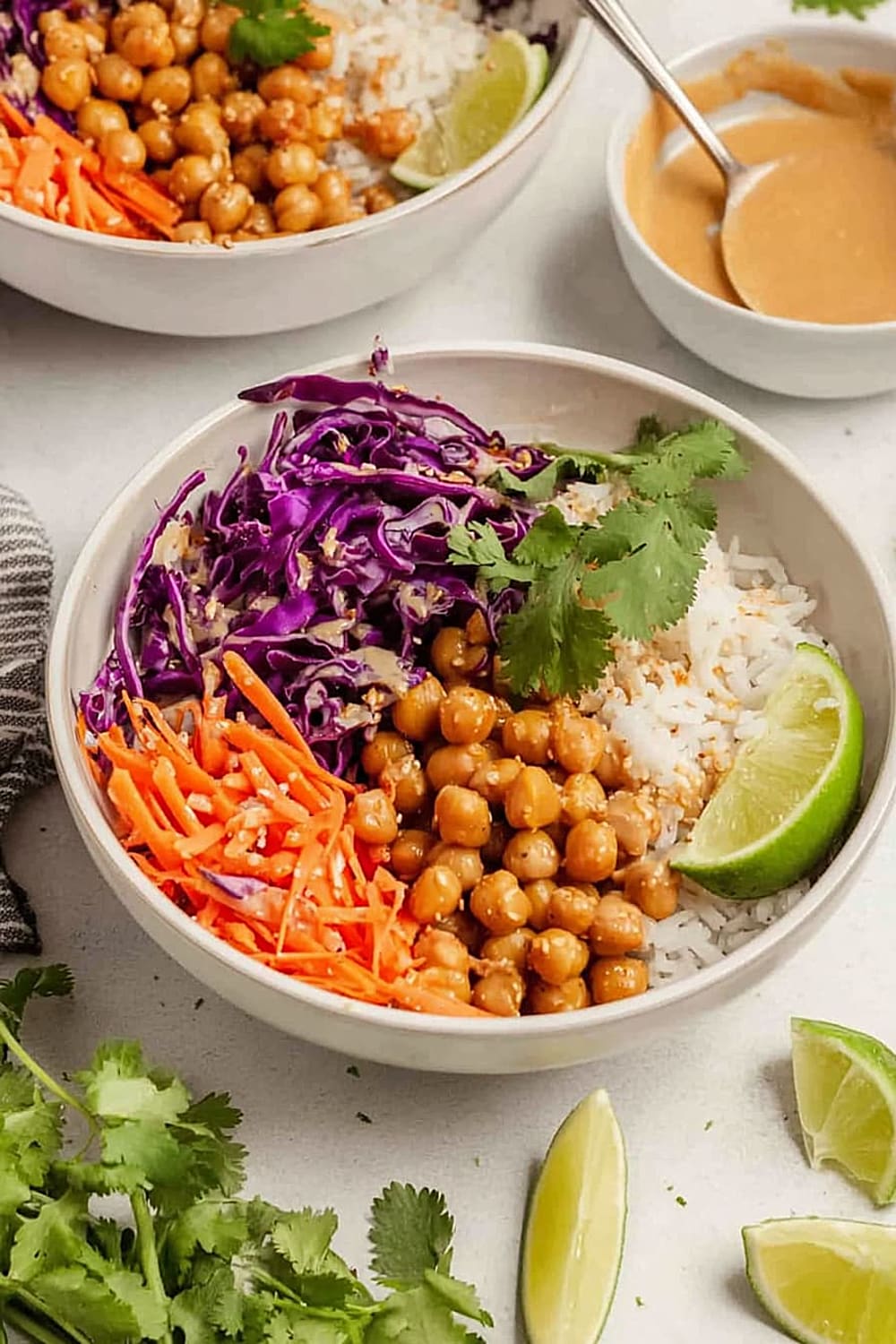
Instructions
Prepare the Rice
- 1 Combine the 1 cup rice with 2 cups water in a small saucepan with a tight-fitting lid. The key to perfect rice is using the right water-to-rice ratio and maintaining consistent heat throughout cooking.
- 2 Bring the mixture to a simmer over medium heat, then immediately reduce heat to LOW. Place the lid on the pan and cook for 18 minutes for white rice or 37 minutes for brown rice. Resist the urge to lift the lid during cooking, as this releases essential steam.
- 3 After the timer goes off, turn off the heat and lift the pan lid quickly. Place a clean kitchen towel on top of the saucepan, then replace the lid immediately. This towel trick absorbs excess moisture and prevents soggy rice. Remove to a cool burner and let rest until needed.
Prepare the Chickpeas
- 4 In a small mixing bowl, combine 1 tablespoon olive oil, minced garlic, freshly grated ginger, 1 tablespoon sambal oelek, 1 tablespoon brown sugar, 1 tablespoon lime juice, and 1 tablespoon soy sauce. Using a microplane grater for the ginger ensures even distribution and prevents large chunks.
- 5 Whisk in the 1 tablespoon cornstarch until completely dissolved with no lumps remaining. The cornstarch acts as a thickening agent that will create that signature sticky coating on the chickpeas.
- 6 Rinse and drain the canned chickpeas thoroughly, then pat them completely dry with paper towels. Removing excess moisture is crucial for achieving proper caramelization. Add the dried chickpeas to the sauce mixture and stir until evenly coated.
Cook the Chickpeas
- 7 Heat a non-stick skillet over medium-high heat until hot but not smoking. You’ll know it’s ready when a drop of water sizzles immediately upon contact.
- 8 Pour the entire chickpea mixture, including all the sauce, into the hot skillet at once. Immediately lower the heat to medium-low and let simmer for approximately 5 minutes. The chickpeas will begin sticking to the pan and developing golden-brown spots – this is exactly what you want.
- 9 Allow the sauce to reduce into a sticky, glossy coating that clings to each chickpea. The natural sugars will caramelize, creating depth of flavor and that irresistible sweet-savory balance.
Make the Peanut Sauce
- 10 In a small bowl, whisk together 3 tablespoons peanut butter, 2 tablespoons lime juice, 1 tablespoon soy sauce, 1 tablespoon brown sugar, 2 teaspoons sambal oelek, and 3 tablespoons warm water. Whisk vigorously until completely smooth with no peanut butter clumps remaining.
Assemble the Bowls
- 11 Divide the rested rice evenly between 4 serving bowls, creating a base layer. Fluff the rice gently with a fork before portioning to ensure light, separate grains.
- 12 Add a generous scoop of the caramelized chickpeas to each bowl, allowing some of the sticky sauce to pool around the rice. Arrange the 2 cups shredded cabbage and 1 cup shredded carrots around the chickpeas for visual appeal and textural contrast.
- 13 Sprinkle the ½ cup chopped fresh cilantro over each bowl and drizzle the peanut sauce generously on top. Serve immediately while the chickpeas are still warm and the vegetables are crisp.
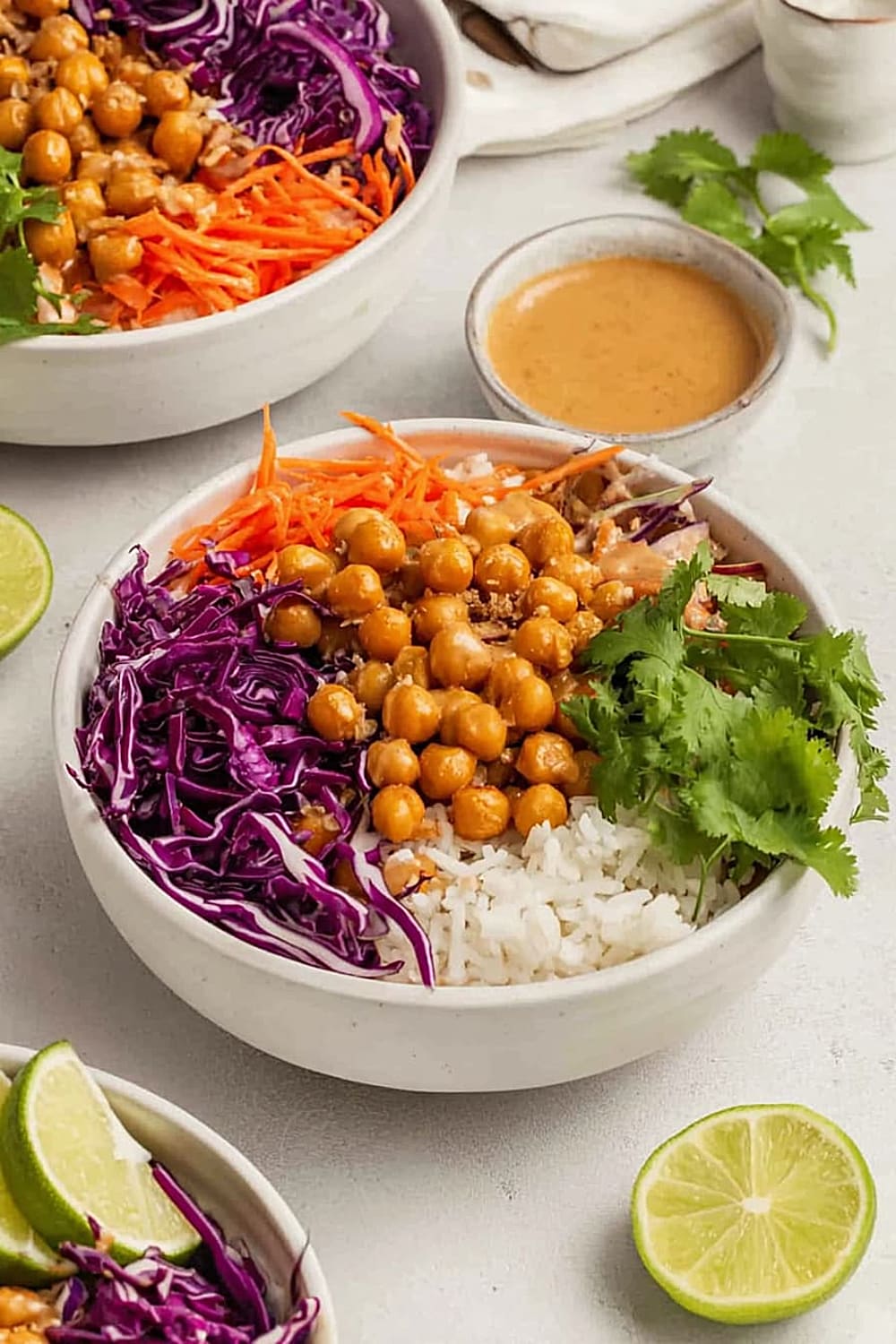
Recommended Equipment and Kitchen Tools
Recommended Tools (for best results):
- Non-stick skillet – Essential for achieving proper caramelization without the chickpeas sticking and burning. A quality non-stick surface allows for easy stirring and prevents the sticky sauce from becoming a cleanup nightmare.
- Microplane grater – Makes quick work of fresh ginger, creating fine, evenly distributed pieces that blend seamlessly into the sauce without overwhelming bites with large chunks.
- Small saucepan with tight-fitting lid – Crucial for perfectly steamed rice. The tight seal traps steam for even cooking and prevents moisture loss.
- Kitchen scale – While not required, measuring ingredients by weight ensures consistent results every time, especially important for the sauce ratios.
Helpful Upgrades:
- Immersion blender – Perfect for creating ultra-smooth peanut sauce if you prefer a completely silky texture. Simply blend the sauce ingredients directly in a tall container for effortless mixing.
- Mandoline slicer – Creates perfectly uniform cabbage and carrot shreds for professional presentation, though a sharp knife works just fine for home cooking.
Nice-to-Have Options:
- Silicone spatula – Ideal for stirring the chickpeas without scratching your non-stick pan surface, and helps scrape every bit of that precious caramelized sauce.
- Mixing bowls in various sizes – Having dedicated bowls for sauce preparation keeps everything organized and makes the cooking process more efficient and enjoyable.

Recipe Variations and Dietary Modifications
Gluten-Free Adaptation:
- Replace regular soy sauce with tamari or coconut aminos using the same measurements. Both provide similar umami depth without compromising the flavor profile.
- Verify that your sambal oelek brand is gluten-free, as some varieties contain wheat-based thickeners.
Protein Boost Variations:
- Add 1 cup cooked quinoa mixed with the rice for complete protein and extra texture
- Top with ¼ cup toasted peanuts or sesame seeds for additional crunch and healthy fats
- Include 1 cup steamed edamame as part of the vegetable mix for plant-based protein
Spice Level Modifications:
- Mild version: Reduce sambal oelek to 1 teaspoon in chickpeas and 1 teaspoon in sauce
- Extra spicy: Add 1 teaspoon sriracha to the peanut sauce and include ¼ teaspoon red pepper flakes with the chickpeas
- Sweet and mild: Replace sambal oelek with 1 tablespoon sweet chili sauce
Vegetable Variations:
- Winter version: Replace cabbage with thinly sliced Brussels sprouts and carrots with roasted sweet potato cubes
- Summer fresh: Add 1 cup cucumber ribbons, ½ cup fresh mint leaves, and ¼ cup sliced radishes
- Hearty option: Include 1 cup steamed broccoli florets or roasted bell pepper strips
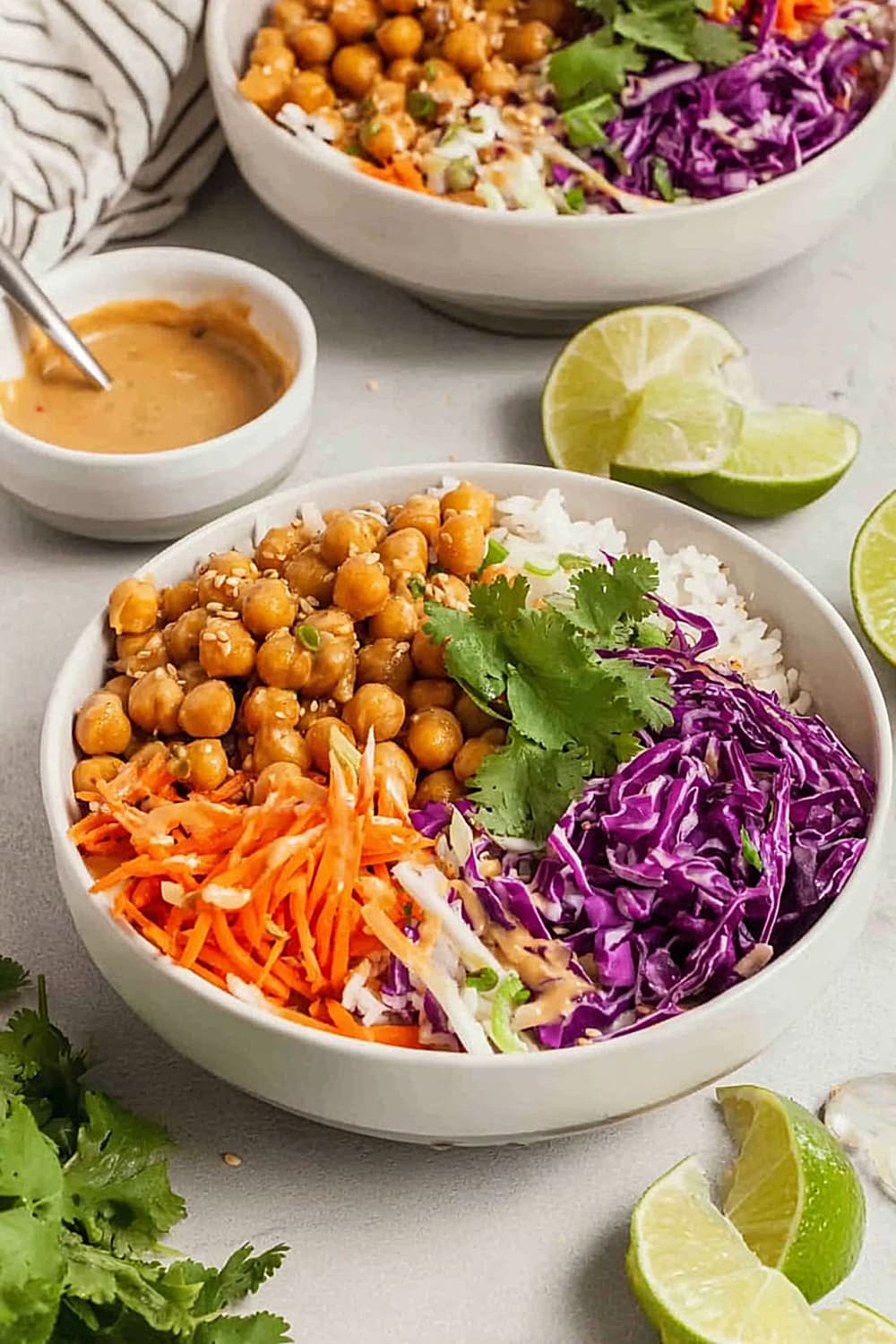
Nutritional Information and Health Benefits
Key Nutritional Highlights:
Each serving provides approximately 420 calories with a balanced macronutrient profile of 65g carbohydrates, 12g protein, and 14g healthy fats. The combination of rice and chickpeas creates a complete protein, containing all essential amino acids your body needs. This bowl delivers 8g fiber per serving, supporting digestive health and promoting satiety that keeps you satisfied for hours.
Health Benefits of Main Ingredients:
Chickpeas are nutritional powerhouses, packed with folate, iron, and magnesium. They provide plant-based protein while supporting heart health through their high fiber content and ability to help regulate blood sugar levels. Fresh ginger offers anti-inflammatory compounds called gingerols, which may help reduce muscle soreness and support immune function.
Peanut butter contributes heart-healthy monounsaturated fats, vitamin E, and niacin. Despite its caloric density, it provides sustained energy and helps with nutrient absorption of fat-soluble vitamins from the vegetables. Fresh cilantro contains antioxidants and may help support natural detoxification processes.
Dietary Considerations:
This recipe is naturally vegetarian and easily adaptable to vegan diets. Contains peanuts and soy (from soy sauce), which are common allergens. The dish is dairy-free and can be made gluten-free with simple substitutions. Each bowl provides about 15% of daily fiber needs and significant amounts of vitamin A from the carrots and vitamin K from the cilantro.
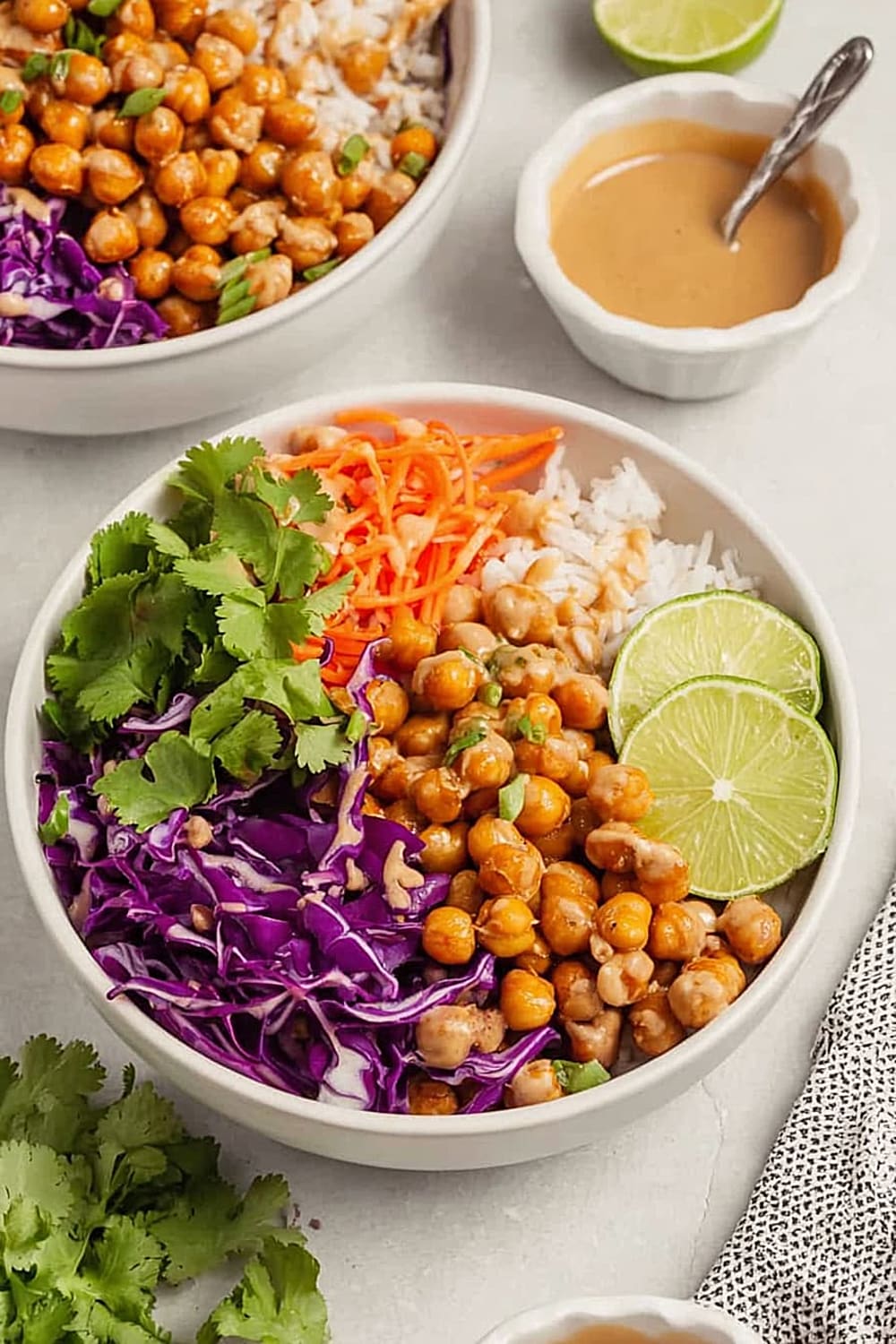
Smart Swaps and Ingredient Substitutions
Common Substitutions:
- Sambal oelek → Sriracha (use ¾ the amount) or chili garlic sauce (equal amounts)
- Fresh ginger → 1 teaspoon ground ginger (though fresh provides better flavor and texture)
- Brown sugar → Coconut sugar or maple syrup (reduce liquid slightly if using syrup)
- Peanut butter → Almond butter, sunflower seed butter, or tahini for nut-free options
Budget-Friendly Swaps:
- Fresh lime juice → Rice vinegar or lemon juice (use slightly less as these are more acidic)
- Pre-shredded vegetables → Whole cabbage and carrots shredded at home (saves 60% cost)
- Canned chickpeas → Dried chickpeas cooked in batches and frozen in portions
Pantry Emergency Substitutions:
- Cornstarch → All-purpose flour (use 1.5 times the amount) or arrowroot powder (equal amounts)
- Soy sauce → Worcestershire sauce mixed with salt (not ideal but workable)
- Fresh cilantro → Fresh parsley, green onions, or fresh basil
Pro Tips for Substitutions:
- When using tahini instead of peanut butter, add 1 teaspoon honey to balance the more bitter flavor profile
- Ground spices lose potency over time – if your ground ginger is over a year old, double the amount for similar impact
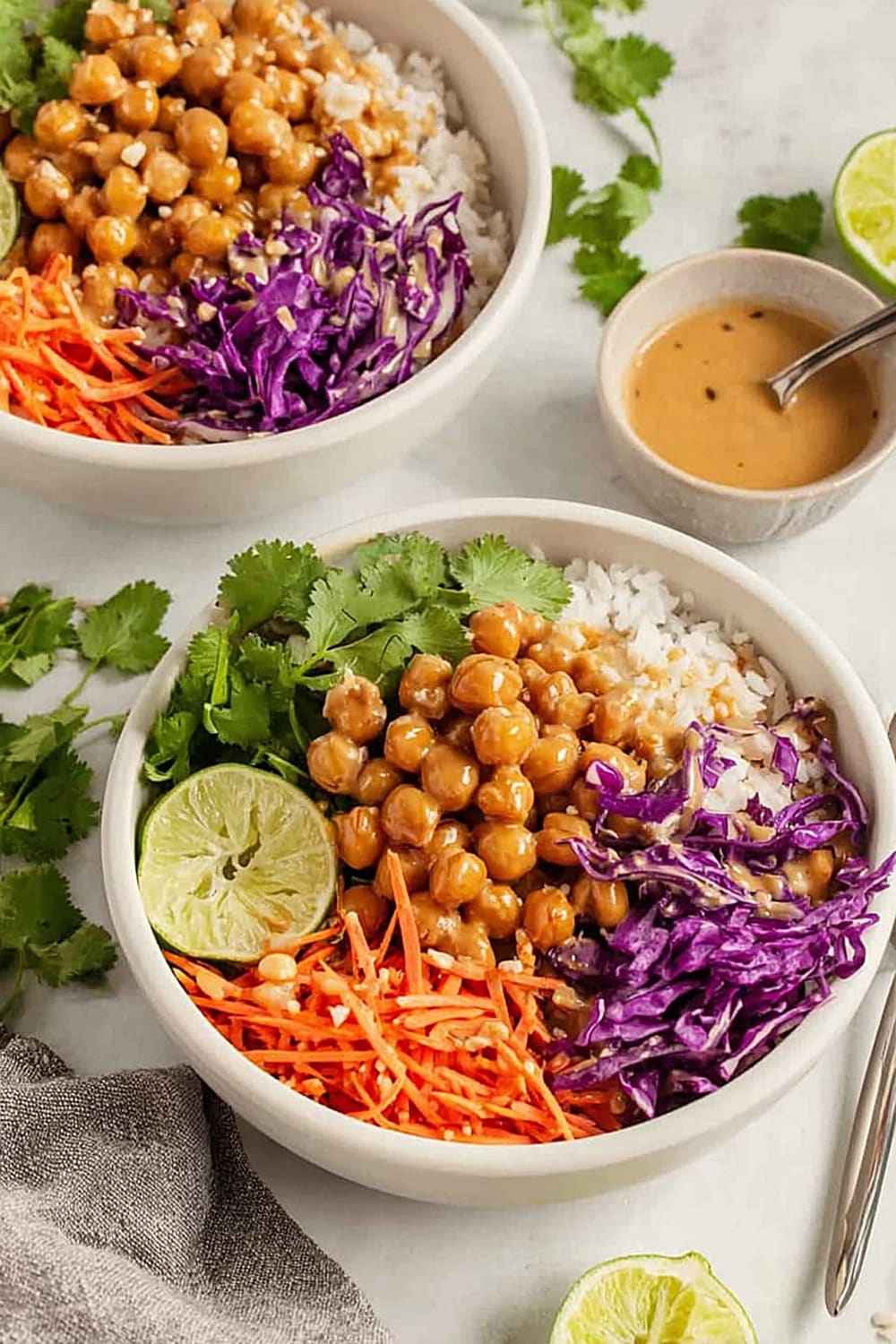
Make It Diabetes-Friendly
Carb Reduction Strategies:
- Replace half the rice with cauliflower rice to reduce carbs by approximately 25g per serving
- Use brown rice instead of white rice for better blood sugar control due to higher fiber content
- Reduce rice portion to ¾ cup total and increase vegetables to 3 cups for similar satiety with fewer carbs
Sugar Substitutions:
- Replace brown sugar in both chickpeas and sauce with stevia or monk fruit sweetener (use 1 teaspoon total instead of 2 tablespoons brown sugar)
- Choose natural peanut butter without added sugars to avoid hidden carbohydrates
- Add extra lime juice and rice vinegar to enhance flavors without relying on sweeteners
Portion & Timing Tips:
- Ideal serving size: ¾ cup of the full recipe paired with a side salad for added fiber
- Estimated carbs per modified serving: 35-40g compared to 65g in original recipe
- Pair with protein: Add 4 oz grilled chicken or ½ cup extra chickpeas to slow carb absorption
Blood Sugar Management:
- Eat vegetables first to create a fiber buffer that slows sugar absorption
- Add 1 tablespoon ground flaxseed for additional fiber and healthy omega-3 fats
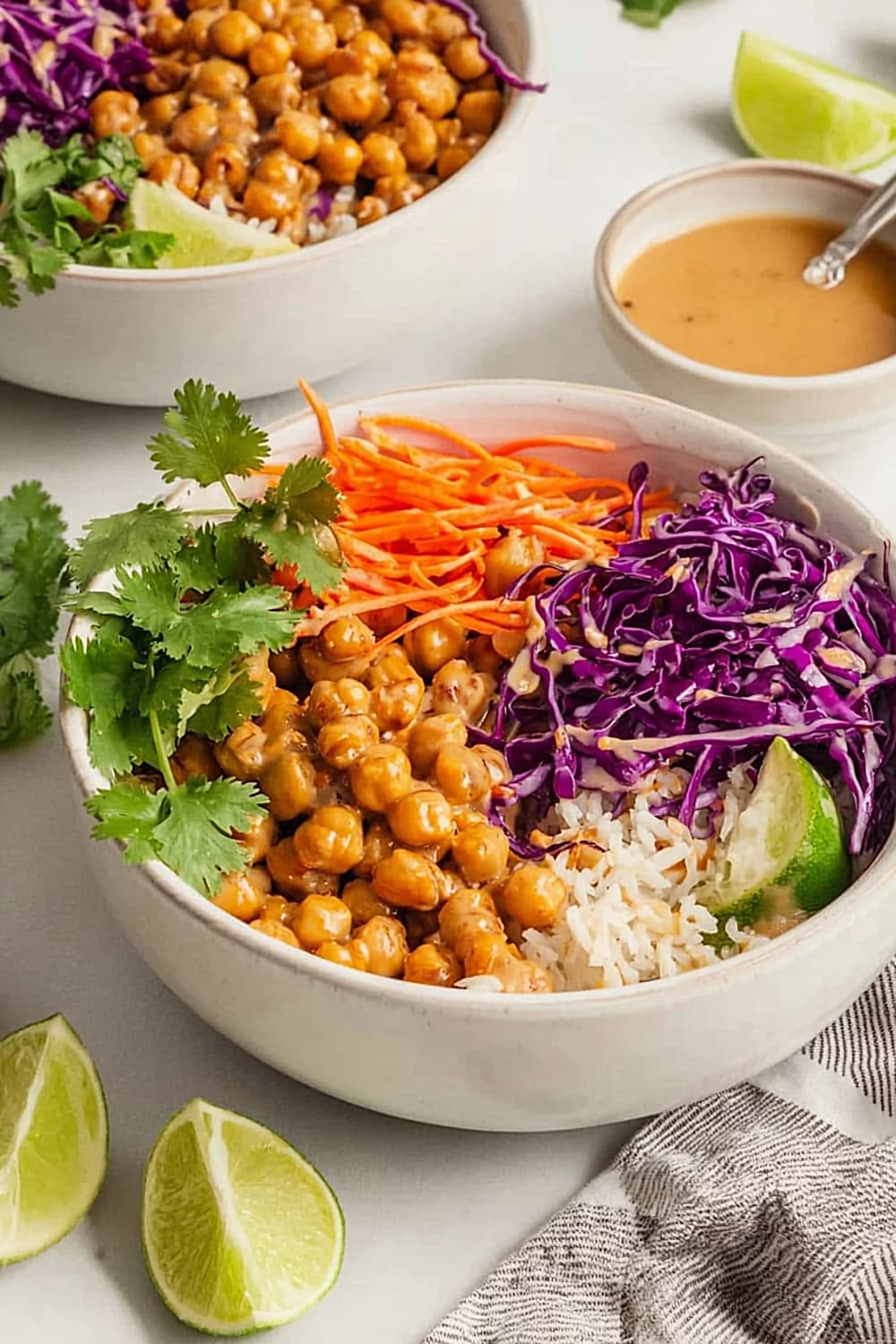
Perfect Pairing Suggestions
Beverage Pairings:
Riesling or Gewürztraminer white wines complement the sweet-spicy flavor profile beautifully, while their slight sweetness balances the sambal oelek heat. For beer lovers, a wheat beer or light lager provides refreshing contrast. Jasmine tea or green tea offer traditional Asian pairing options, while sparkling water with lime cleanses the palate between bites.
Side Dish Recommendations:
Vietnamese spring rolls with fresh herbs create a light, complementary appetizer that won’t compete with the bowl’s flavors. Miso soup adds warmth and umami depth, while Asian cucumber salad provides cooling contrast to the spicy elements. Steamed edamame with sea salt offers additional protein and creates a cohesive Asian-inspired meal.
Complete Meal Ideas:
Start with vegetable summer rolls and miso soup, follow with these chickpea bowls, and finish with fresh mango slices or coconut ice cream for a restaurant-quality experience at home. For casual entertaining, serve alongside Vietnamese bánh mì sandwiches and Asian slaw for a build-your-own bowl bar concept.
Occasion Suggestions:
Perfect for meal prep Sundays, casual dinner parties, or weeknight family dinners when you want something special without extensive preparation. The colorful presentation makes it ideal for lunch entertaining or potluck contributions. Components can be prepared ahead for busy weeknight assembly.

Pro Tips and Troubleshooting
Achieving Perfect Caramelization:
The secret to restaurant-quality chickpeas lies in patience and proper heat control. Don’t rush the caramelization process – let those chickpeas sit and develop golden spots before stirring. If they’re not browning, increase heat slightly, but if the sauce burns before the chickpeas caramelize, lower the temperature and add 1 tablespoon water to deglaze.
Sauce Consistency Solutions:
If your peanut sauce becomes too thick, whisk in warm water 1 teaspoon at a time until desired consistency is reached. Conversely, if it’s too thin, let it sit for 5 minutes – natural peanut butter often thickens as it settles. Room temperature peanut butter mixes more easily than cold.
Storage and Make-Ahead Strategies:
Cooked rice keeps refrigerated for 5 days and reheats beautifully with a splash of water in the microwave. Caramelized chickpeas maintain their texture for 3 days refrigerated but are best reheated in a skillet rather than microwave to preserve that sticky coating. Peanut sauce stays fresh for 1 week refrigerated and may need whisking before serving.
Scaling and Presentation:
This recipe doubles perfectly for meal prep or entertaining – just use a larger skillet and extend cooking time by 2-3 minutes. For elegant presentation, use shallow bowls and arrange components in distinct sections rather than mixing everything together. Garnish with lime wedges and extra cilantro for restaurant-style appeal.

This vibrant, satisfying meal proves that healthy eating doesn’t mean sacrificing flavor or spending hours in the kitchen – sometimes the best dishes are the ones that make you feel accomplished while keeping your taste buds completely happy.